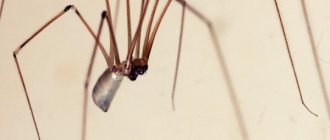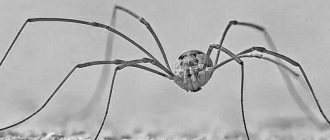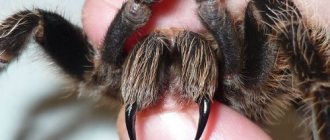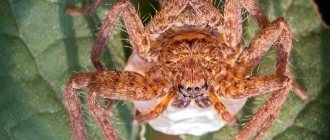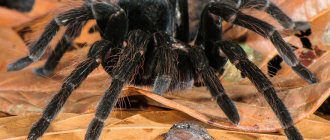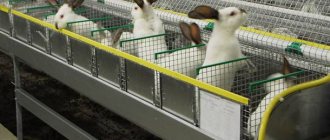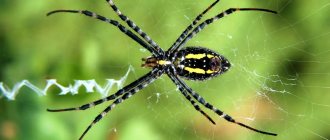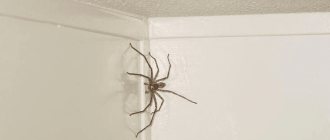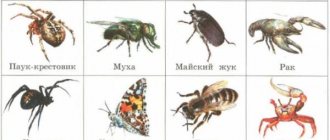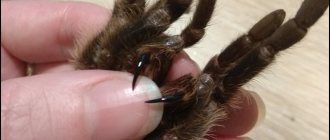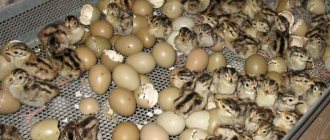During its life, the spider goes through several stages of development. In the first stage, the arachnid is inside one of hundreds of eggs that the female lays in a cocoon.
Not all spiders will be able to survive and become adults, since many of them will be eaten by their own brothers or die for other reasons.
Let's look at what a spider's cocoon consists of, how reproduction occurs, and how many eggs there are in one clutch.
Order: Araneae = Spiders
...The reproduction biology of spiders, in terms of the complexity and originality of the observed phenomena, surpasses everything that is characteristic of other arachnids, and this is again associated with the use of webs.
Sexually mature male spiders are usually very different from females in their lifestyle and appearance, although in some cases males and females are similar. Usually the male is smaller than the female, with relatively longer legs, and sometimes the males are dwarf, 1000-1500 times smaller in volume than the females. In addition to size, sexual dimorphism is often manifested in certain secondary sexual characteristics: in the bright pattern of males, in the special shape of individual pairs of legs, etc. Males, as a rule, are found less frequently than females, and in some species they are not found at all. At the same time, the virgin development of eggs in spiders appears to be a rare exception. In tenet spiders, sexually mature males usually no longer build trapping nets, but wander around in search of females and are caught in the female’s nets during a short mating period.
The internal organs of the reproductive system of spiders generally have a fairly common structure. The testes are paired, convoluted vas deferens are connected near the genital opening, which in the male has the appearance of a small slit. The ovaries are paired, in some cases fused at the ends into a ring. Paired oviducts are connected into an unpaired organ - the uterus, which opens with the oviductal opening. The latter is covered by a folded elevation - the epigyne. There are seminal receptacles - sacs from which the tubules extend to the excretory part of the genital tract and to the epigyne, where they usually open independently of the ovarian opening.
The copulatory organs are formed on the male's pedipalps only during the last molt. Before mating, the male secretes a drop of sperm from the genital opening onto a specially woven arachnoid mesh, fills the copulatory organs of the pedipalps with sperm, and during mating, with their help, introduces sperm into the seminal receptacles of the female. In the simplest case, on the pedipalp tarsus there is a pear-shaped appendage - a bulbus with a spiral spermatic canal inside (Fig. 35.5). The appendage is extended into a thin spout - an embolus, at the end of which a canal opens. During mating, the embolus is inserted into the female's seminal receptacle. In most cases, the copulatory organs are more complex, and the ways of their complication can be traced within the order and are somewhat different in different groups of spiders. Usually the tarsus of the pedipalps are enlarged. The articular membrane of the bulbus turns into a blood receptacle, which, at the moment of mating, swells like a bubble under the pressure of the hemolymph. The spermatic canal forms complex loops and opens at the end of a long embolus, tourniquet or other shape. There are often additional appendages that serve for attachment during mating. The structure of copulatory organs in detail is very diverse, characteristic of individual groups and species, and widely used in the taxonomy of spiders.
The male fills the pedipalp bulbs with seed shortly after the last molt. The sperm mesh has a triangular or quadrangular shape and is suspended horizontally. The male immerses the ends of the pedipalps into a drop of sperm secreted onto it. It is believed that sperm penetrates through the narrow canal of the embolus due to capillarity, but it has now been established that at least in forms with complex copulatory organs there is a special seminal suction canaliculus. In some spiders, the male does not make a web, but pulls one or several webs between the legs of the third pair, releases a drop of sperm onto the web and brings it to the ends of the pedipalps. There are also species whose males take sperm directly from the genital opening.
The male, with copulatory organs filled with sperm, goes in search of a female, sometimes covering considerable distances. In doing so, he is guided mainly by his sense of smell. He distinguishes the odorous trail of a mature female on the substrate and her web. In most cases, vision does not play a significant role: males with blurred eyes easily find females.
Having discovered a female, the male begins “courtship”. Almost always, the male’s excitement manifests itself in certain characteristic movements. The male twitches the threads of the female's net with his claws. The latter notices these signals and often rushes at the male as prey, causing him to flee. Persistent “courtship,” sometimes lasting for a very long time, makes the female less aggressive and prone to mating. Males of some species weave small “mating nets” next to the female’s snares, into which they lure the female with rhythmic movements of their legs. In burrow-dwelling spiders, mating occurs in the female's burrow.
In some species, repeated mating with several males and competition between males is observed, which gather on the female’s snares and, trying to get closer to her, fight with each other. The most active one drives away rivals and mates with the female, and after some time another male takes his place, etc….
Behavior
The jumping spider prefers to lead a solitary lifestyle. He hunts only in the daytime, spending the night in a secluded shelter, which is most often a crack in a tree or a crevice in a rock. At night he weaves himself a cradle, in which he sleeps sweetly until the morning. In inclement weather, he can spend several days there, patiently waiting for more suitable conditions for hunting.
Having left the shelter early in the morning, the spider first basks in the sun and, only after being well warmed up, goes fishing. Horses are distinguished by their innate courage and run away only in exceptional cases, constantly turning their heads and looking back at the pursuer.
Well-developed limbs allow them not only to run fast, but also to tirelessly make jumps that are approximately 20 times their body size. Before each jump, the spider attaches a safety thread to the substrate to avoid an accidental fall.
Binocular vision allows him to very accurately determine the distance to the landing site, so unsuccessful jumps are extremely rare. In flight, the spider always extends its forelimbs forward, which in males are much better developed than in females.
The spider notices the slightest movement around itself thanks to three pairs of eyes located on the sides of the cephalothorax. Having noticed the victim with their help, he slowly turns his head towards her.
Two large front eyes accurately determine the distance. Next, the predator slowly creeps up on the prey from the side or behind. Having gotten close enough, he makes a lightning-fast jump with his legs widely spaced. The first pair of limbs tightly grabs the victim, and the chelicerae pierce the chitinous cover, injecting a dose of poison and digestive juices into its body.
The poison acts very quickly on insects, but is completely harmless to humans. Digestive juices soon turn the insides of the prey into a liquid pulp, which the spider drinks with appetite. The diet of jumping spiders includes flies, mosquitoes, bugs and ants. They spend the winter safely hidden in a secluded shelter.
Spiders - what are they: types
Researchers know about 42 thousand species of spiders. Spiders can be divided into three large suborders, which differ mainly in the structure of the jaws, or more precisely, in the position of the chelicerae relative to the longitudinal axis of the body.
Suborder Orthognatha
More often, representatives of this suborder are called migalomorphs. They are characterized by the presence of thick hairs, large sizes and a primitive structure of the jaws - the claw is directed downwards and grows only on the upper jaw. The respiratory system is represented by pulmonary sacs.
The majority of mygalomorphs live in warm climates. They make burrows underground.
Orthognatha includes:
- tarantula spiders
- funnel spiders
- ctenizidae
- digger spiders
Representative of the suborder Araneomorpha
Suborder Araneomorpha
Almost all other species of spiders known to naturalists belong to the large group Labidognatha or Araneomorpha. They differ in that both jaws are equipped with claws. The respiratory system is represented by the trachea.
Types of spiders that catch prey without a net:
- crab spiders
- jumping spiders
- wolf spiders
Types of spiders using a trapping net:
- linifid spiders
- web spiders
- funnel spiders, or house spiders
- long-legged spiders
- orb weaving spiders
Among the araneomorphic spiders, there are also those that are not capable of producing cribellum, the substance from which spiders produce strong web silk, and those that produce it.
Suborder Mesothelae
Lyphistiomorphic spiders are distinguished by the fact that the chelicerae are spread out to the side rather than pointing downwards. This position is considered more evolutionarily advanced. But this suborder is considered the most primitive; traces of it were found in Carboniferous deposits. Spiders have archaic pulmonary sacs and four pairs of arachnoid warts, which have not yet been moved to the end of the abdomen. They live in earthen burrows that are closed with a lid. Signal threads radiate from the minks. Although one species prefers caves, where it makes web tubes on the walls.
These include:
- arthropod spiders
- primitive arthrolycosid spiders
- primitive arthromigalid spiders
Blue tarantula spider
Species and subspecies
It is very difficult to answer the question of what spiders are, since representatives of this order are very numerous and diverse.
Currently, scientists know more than 42,000 species of spiders. All of them are predators; representatives of about 60 species occasionally eat plant food, and only one species feeds exclusively on plants.
According to the generally accepted classification, all spiders are divided into 3 suborders:
- Mesothelium;
- Opistotle Araneomorpha;
- Opistotle
Representatives of the mesotel suborder are considered the most primitive. They live mainly in holes in the ground, the entrance to which is closed with a kind of lid.
Spiders of the suborder Mygalomorphae or migalomorphae are large, with heavily pubescent bodies and legs. The vast majority live in regions with warm climates.
The suborder Araneomorpha is considered the most numerous. This includes arthropods that hunt with a web, do without it, as well as those who do not know how to weave a web at all.
All about spiders
- There are approximately 40,000 species of spiders in the world.
- The life of each spider is such that in a year it kills approximately 2000 harmful insects that inadvertently fall into its sticky webs. Basically, the victims of many spiders are flies and mosquitoes.
- If you read everything about spiders, you will know that the size of these creatures, depending on their variety, can be from 0.4 mm to 10 cm. Moreover, the span of the spider’s limbs often exceeds 25 cm.
- The color and pattern on different types of spiders depends on the structural structure of the integument of hairs and scales, as well as on the presence and localization of different types of pigments. In this regard, such creatures are painted both in a dull monochromatic color and in a bright tonality.
Body structure
These amazing creatures have 2 sections of their body. This is the abdomen and cephalothorax, which are connected to each other by a thin membrane. If you carefully examine the spider, it becomes clear that arachnids have a cephalothorax with a certain division into the thoracic and cephalic parts, provided by a thin groove.
On the head of each spider there are organs such as chelicerae, which are formed by the first pair of limbs; pedipalps, which are formed from the second pair of limbs, eyes and mouthparts. These are the characteristics and descriptions of each representative of the arachnid genus.
What will be interesting for children is that spiders do not have a complete circulatory system. They also don't have blood. It is replaced by lymph.
As for the spider’s brain, it occupies on average a quarter of the total volume in its body.
Spiders have a heart, but it has a peculiar structure and consists of 3 or 4 holes. Through these openings, lymph enters the heart area, after which it flows throughout the body, ending up in the areas between the internal organs.
The respiratory organ of spiders also has a unique structure. The respiratory system of such creatures consists of pulmonary sacs, which are made in the form of plates resembling books.
Each representative of arachnids has 8 legs, and each leg has 6 knees.
Habitat
Spiders are ubiquitous in the world and live on all continents of the globe.
Interesting spiders do not live only in areas where the surface of the earth is hidden under ice all year round.
What are ticks
Ticks are just small arachnid arthropods that have lived for millions of years and inhabited the Earth long before humans appeared on it. Therefore, it can be argued that as long as a person lives, he is accompanied by bites from representatives of this family.
Ticks can rightly be classified as faithful and constant companions of all living things - for millions of years, where there is vegetation or living creatures, these spiders can be found from hot Africa to the harsh taiga of the Eurasian continent, from deserts to rainforests.
That is, it is difficult to find a place on the planet where ticks do not live.
A misconception is the belief that all ticks are parasitic and drink blood, much less live on humans or animals. In fact, of the 48,000 species known in scientific circles today, only the order Ixodida, numbering over 900 representatives, prefers the blood of humans, warm-blooded animals, birds and even reptiles as food.
There is a separate family of tiny parasites that penetrate the skin and constantly parasitize inside the body of animals and people, but the spread and reproduction of such mites largely depend on basic hygiene. The rest of the ticks live in various types of vegetation, feed on plant components, organic matter, their relatives or their remains, posing no threat to humans.
Which ticks are dangerous to humans and pets?
People, fearing for their own health and for the well-being of their animals, should have information about those parasites that carry a real risk of developing dangerous infections. There are conditionally 2 types of such mites - permanent and temporary parasites.
Constant parasites
These tiny arachnids, burrowing under the skin of warm-blooded animals and humans, live there constantly, that is, throughout their entire life cycle, causing undeniable harm through their own vital activity.
As a rule, acariasis is caused by the following permanent parasites:
- Ear mites affecting the outer ear and ear canal.
- Scabious itching affecting the subcutaneous layers.
- Demodicosis, when the face and the area around it are mainly affected.
Prevention consists of strict adherence to hygiene rules, especially where such ticks and their carriers live.
Temporary Parasites
The only order that, during its own evolution, transformed into the form of temporary parasites is Ixodida. Only two families of this order - Argasidae and Ixodidae - pose a real threat with their bites to people and domestic animals.
Because they are able to climb onto a victim, pierce the skin, drink blood and thereby provoke a number of serious problems.
It is their accidental bites, possible during walks and trips into nature, that people rightly fear, wanting to avoid the following unpleasant and sometimes dangerous moments:
Infection of the bitten person with pathogens of dangerous diseases. Itching and allergic reactions. Dermatitis and other skin lesions.
After saturation, the process of which can last for a week in an adult female, and several hours in a male, the bloodsucker falls off on its own. If the parasite is not detected and removed in time, it will suck blood as much as it needs.
Argasid mites
Not all representatives of argasid mites are capable of causing harm with their attacks in our region; residents of South America suffer from the majority of them. In our latitudes, the most likely danger from this family is the following representatives:
- The village tick, which lives near large livestock and poultry, parasitizes them, transmitting the pathogens of borelliosis and relapsing fever to humans when biting them.
- The shell mite, which most often lives in pigeon nests and parasitizes pigeons, the bite of which causes severe allergies in humans; also suspected of carrying Q fever.
These bloodsuckers are interesting to scientists because of how long the tick lives without feeding. About 10 years! During forced hunger, the parasite goes into hibernation, and all life processes slow down. But when a source of food appears, activation quickly occurs and the tick is ready for an immediate attack.
In reality, argas parasites rarely attack people, since they still prefer more familiar hosts.
With the onset of periods of hunger, they are capable of migrating over long distances on the body of the victim, attaching themselves to it. This is especially true for birds that carry ticks for several thousand kilometers.
Spider in the house: good or bad
Spiders are not pets. They live in the wild, but can easily settle in a house or apartment if the living conditions are suitable for them and food is constantly available. By understanding what spiders feed on, you can prevent them from appearing in your home. Favorite delicacies of arthropods:
- mosquitoes;
- cockroaches;
- flies.
The answer to why there are many spiders in the apartment is simple - the more of these insects there are in the house, the more hunters for them will appear. The solution to the problem is simple - tighten cleaning, including in hard-to-reach places.
Myth 10. Harvesters are poisonous, but have no fangs.
Image: Thomas Henkel / Wikimedia Commons
There is another everyday myth. Allegedly, haymakers, or mowing spiders - well, those spiders with disproportionately long legs that you probably met at the dacha - are incredibly poisonous. But they cannot harm anyone because their jaws are too short. Or, in some variants, no mouth at all.
This is wrong. Haymakers do not have MR Berenbaum. The Earwig's Tail: A Modern Bestiary of Multi‑legged Legends poisonous glands, and their chelicerae are not hollow, but grasping fangs. They can hunt small insects, but do not pose a danger to people. And even if they wanted to, they wouldn’t even be able to bite through the skin.
How spiders get into the house
Arthropods appear in an apartment or house by penetrating:
- through windows;
- through doors;
- through the attic;
- through the basement;
- on clothes;
- on flowers or purchased plants brought from the street.
How good is this or, on the contrary, bad for a person and the main thing is whether it is necessary to kill uninvited “guests” if the fate is that spiders actively reproduce, littering the house with cobwebs and traces of vital activity. In fact, a lot depends on the superstitiousness of the home owners.
If they believe in omens, then most likely they consider spiders to be symbols of good luck, income, and success. However, signs associated with spiders are not always positive. Many, not knowing for sure whether spiders in the house are good or bad, believe that they can bring bad luck, illness, and even provoke adultery.
“Don’t kill the spider, it’s better to let it out!”
Anyone who lives with a compassionate animal lover has likely heard the following more than once: “don’t hit a spider with a rolled-up newspaper, just pick it up and take it outside.” In this case, everyone wins. You no longer have to think about the spider, and the spider can return to its natural habitat alive.
That is, of course, until he freezes to death. Most spiders found in the home have adapted to living indoors and cannot survive outdoors. This is especially true for Europe. While many people fear all spiders indiscriminately, house spiders are for the most part harmless to humans, as they cannot pierce human skin. So even if you release spiders outside with good intentions, there is a good chance that they will still die.
How does mating happen?
The cage of fattened individuals is always carried out on the territory of the female. Experts recommend preparing the terrarium immediately. The drinking bowl and all decorations are removed from it, leaving only an object that serves as a refuge for the spider.
The soil is moistened. Bring the percentage of air humidity to 60%. The terrarium must have good ventilation.
For individuals of the burrow type, the depth of the litter is increased to 15 cm. Females will begin to rebuild the burrow, equipping it with a nursery for nymphs. The soil is combined from coconut substrate, vermiculite, sphagnum. Breeding tarantula spiders at home requires following certain rules.
The spider is placed in a terrarium with a female. He begins to explore the territory. It takes him some time to do this. You should not push him with tweezers or direct him towards the female. At this time, the spider may be in its shelter or sitting on the litter; she waits for manifestations of activity from the male. When spiders are ready to mate, they call for a female by tapping their pedipalps on the ground.
The male slowly approaches the spider. If she is ready for fertilization, then there will be no aggression from her. She raises her upper limbs into a vertical stance. At the same time, a gap opens in her epigastric groove in which the ovaries are located. In female tarantulas this is a paired organ.
The spider holds the female in an upright position with its tibial hooks. It touches the slit in the furrow with its pedipalps, releasing seminal fluid from the bulbs. After mating is completed, the tarantula lowers the female and quickly runs away so as not to experience her aggression.
At this point, keepers need to react quickly; disconnect the male from the female, remove him from the terrarium. Otherwise, you may lose it.
The process of female fertilization does not end there. Another male is placed next to the spider. Sometimes mating of tarantula spiders continues until the female becomes overly emotional.
Spiders reproduce in natural conditions once a year. When keeping at home, you must follow these rules.
There are always spiders within a radius of one meter from a person
This myth is pure nonsense. We can't even begin to imagine how many spiders there are in the world, but to assume that you can't even stand up or lie down without hitting a spider is simply ridiculous. The myth began when archaeologist Norman Platnick began his 1995 paper by saying, “wherever you are sitting reading this, a spider is probably no more than a few feet away.” People took this as a fact when in fact he was just speculating. Over time, a few meters grew into a meter, and the word “probably” was dropped altogether. By 2001, books were citing this myth as fact.
Making a nest
More precisely, it’s not us who make things, but the mother of spiders. These arthropods develop in eggs. The spider keeps it securely in a cocoon.
But first things first. First, the future mother spider weaves a nest. A “backing” is woven under the eggs. It is a soft web. Eggs are laid on this web. And the top is covered with another layer of cobwebs. The result is pancakes made from spider webs with an egg-shaped filling between them.
After the pancake is ready, the spider turns it into a cocoon. And attaches it to the wall of the nest. In it, the eggs mature, and the baby spiders inside are preparing to be born.
Why do spiders die after giving birth?
Spiders
-cannibals
During the first two weeks, the spider feeds the children with regurgitated juice, while losing 41% of its body weight. … After
After the offspring eats all the entrails, only 4% of the female’s original body weight remains and she, naturally,
dies
.
Interesting materials:
How to install a fork player on a Hisense TV? How to install APPX format? How to install PDF format? How to set photo on Huawei y7 2022 contact? How to set a photo to Apple ID? How to install gallery on Android? How to install GB WhatsApp? How to install a Hertz monitor? How to install global firmware on xiaomi? How to install gmail on android?
Number of spiders
How many spiders are born at a time? Given that the clutch consists of a fairly large number of eggs, it is difficult to predict how many babies will see the light of day. A spider can weave one cocoon and lay 5 eggs in it. Or he can work on several with a total number of eggs of about a thousand. This happens extremely rarely. Most often, the number of cocoons with clutches reaches 10. Now imagine that each of them contains five eggs. And this means that fifty baby spiders will be born.
How many people are killed by elephants per year?
elephants commit 100 human kills each
, 500 each - hippopotamuses, 1000 each - crocodiles, 2000 - helminths, 9000 - tsetse flies (carriers of sleeping sickness).
Up to 40,000 people a year
.
Interesting materials:
Is it possible to do lymphatic drainage massage? Is it possible to massage with essential oil? Is it possible to massage with vegetable oil? Is it possible to massage with a brush during menstruation? Is it possible to massage with a brush for varicose veins? Is it possible to do almond peeling in summer? Is it possible to do push-ups every day? Is it possible to make patches at night? Is it possible to do scalp peeling if you have hair loss? Is it possible to peel acne?
Spider Mom
Speaking about how spiders are born, one cannot fail to mention the “merits” of their mother. The spider is the guardian of her babies. She valiantly guards the cocoon, and if anyone dares to encroach on the treasure, death awaits him. While the babies are developing in the eggs, the spider loses a lot of weight. After all, she doesn’t go out to get her own food. As a result, her abdomen shrinks very much and becomes wrinkled. The spider often dies near the nest, without waiting for the children to hatch.
If the new spiders in this world are lucky and they find their mother alive, then a better guard will not be found. A mother is able to recognize her children by feeling them with her pedipalps. And woe to the spider that finds itself in the zone of her groping. At best, he'll kick you out. Otherwise, he will kill. This is a threat to your beloved children.
Feeding features of insects
Being voracious predators, spiders usually feed on insects by suction. Many people wonder whether spiders eat cockroaches, and in some cases the answer may be yes. This applies to domestic animals. The prey - the victim of spiders - must be killed using poison. If it is a small insect, death occurs instantly; if the victim is large, it struggles in the predator’s nets. Certain food items that arachnids eat are small insects, and they must be suitable in size ratio. Many individuals eat cockroaches of all types, bedbugs, flies and bugs.
Birth of spiderlings
How are spiders born? Let's start with how the baby develops. The spider lies in the egg, right on the yolk of the egg. And it comes together in one heap. Before this it was segmented. And then all his body parts—segments—merged together. And the spider began to resemble a normal arthropod creature: there was an abdomen, eight legs, and a head, gradually turning into a chest, with eight eyes.
Our baby has grown up. The egg is cramped for him. This is where the shell of the egg bursts. Or the spider itself makes its way to the exit, breaking the shell. If the mother is alive and nearby, she will help the offspring get out. If not, then the little ones should sit in the remains of the shell and wait for the first molt. Little spiders are funny: they are hairless and colorless. They cannot eat or weave webs on their own.
Myth 7. Spiders have stingers on their bellies.
Image: Elena Taranenko / Unsplash
The giant spider Shelob in Tolkien’s “The Lord of the Rings” was equipped with exactly this. She stung Frodo in the neck with it, causing him to temporarily fall into a coma.
The writer was bitten by a tarantula as a child and eventually developed arachnophobia. Apparently, this is why he collected the most disgusting features in Shelob - a sting, a “stalked neck”, eyes hanging in clusters.
But the author apparently confused the spider with a wasp: these arthropods do not have stingers at the end of their bodies. They bite exclusively with the chelicerae, that is, with the mouth. On their tail, however, are M. Pechmann. Patterning mechanisms and morphological diversity of spider appendages and their importance for spider evolution / Arthropod Structure & Development. And in some species they are quite large and can look like an extra pair of legs. But they do not emit poison - only cobwebs.
Brief description of eggs and cocoon
Spiders lay eggs in a web cocoon. It consists of two layers, between which there is a loose layer.
The web protects the masonry from the following dangers:
- drying out;
- mechanical damage;
- bacteria;
- parasites;
- fungi;
- temperature jumps.
Basically, spider eggs consist of a nutritious yolk. They are covered with chorion and vitelline membrane. Quite elastic to the touch. With strong mechanical stress, the shell is very easy to destroy.
The color of the shell may vary depending on the species. In the nests of different species you can find almost all the colors of the rainbow, in addition, these colors can be very bright.
Some eggs are poisonous to mammals. Moreover, their toxicity does not depend on the degree of toxicity of the spider that carried them. An animal that eats such a clutch may die.
The cocoon consists of a web, which is why it is painted white, but can have different shades. Sometimes spiders coat their webs with a special enzyme, which makes the shell dense. It protects the masonry from moisture and bacteria.
Spiders can hide cocoons:
- on the ground;
- under fallen leaves;
- under stones;
- attach to branches.
In some species, the web does not reflect ultraviolet light or reflects only some spectra, due to which the cocoon becomes visually less noticeable among the foliage.
Myth 9. And in bananas
Image: Stuart J. Longhorn / Wikimedia Commons
By the way, there is another popular legend. It says that giant crab spiders lay cocoons with eggs in bananas. The fruit is then collected, transported halfway around the world and sold in supermarkets. Some unlucky person buys a banana, starts peeling it, and a furry monster jumps out! Or, as an option, a whole swarm of spiderlings.
Usually they add to the legend that, unlike people, monkeys have a special technique for cleaning these fruits and do not disturb the cocoons.
Therefore, they are not afraid of spiders and only laugh at their hairless relatives.
But this is also a myth Myth: The tip of a banana should not be eaten because there could be spider eggs inside / Burke Museum: even the toughest spiders cannot bite through the banana peel. And they have absolutely no need to leave offspring inside fruits: they are obligate predators. Only one spider is known to eat vegetarian food, Bagheera kiplingi, but it also prefers acacia leaves. Although from hunger he may resort to cannibalism.
Theoretically, of course, an arthropod can attach eggs to the outside of the fruit. But such a thing as the cocoon of a giant crab spider is very difficult to miss while picking fruit.
How spiders lay eggs
Spiders are known for eating the males after mating. This is necessary so that the body is saturated with a sufficient amount of nutrients that are needed to maintain pregnancy.
This is why females live much longer than males, and each clutch significantly shortens their life.
Females of some species spend all their resources on protecting their offspring, and therefore die from exhaustion. Other species do not care about their offspring at all.
After fertilization, the female begins to weave a cocoon. Its shape and strength depend on whether it will be placed in a secure nest or in an open area.
The cocoons that are located outside the nest have much denser webs. Some females wear the cocoon on themselves. From the outside it may seem like a spider is crawling with an egg on its belly. The mother protects the offspring until the spiders come out.
Burrowing species weave a cocoon from two web plates. They lay it on a smooth web sheet, and then tie it with a covering web on top.
Other species weave a round bag in which they leave a small hole. The spider lays eggs through it. Afterwards the hole is closed with cobwebs.
Tenet species hang a cocoon on a spider web not far from their hunting nets. After laying eggs, the female stops feeding and devotes all her energy to protecting the offspring.
In this case, the juveniles stay inside the web shelter in winter, and come out with the arrival of spring. By this time, the female is already dying from cold and exhaustion.
Inside the web's shelter, spiders go through several stages of development. At first they become nymphs: the egg develops short legs.
Then, with each molt, the nymphs become more and more like small spiders. When it’s time to go outside, the juveniles tear apart the web with the help of chelicerae. Some species destroy webs using a special enzyme.
The species Agroeca brunnea creates a pear-shaped cocoon that attaches to grass or twigs. It consists of two sections. One is used for storing masonry, and the other is for molted spiderlings. The juveniles stay there for about 3 weeks.
Often the females protect and care for the cocoon. They can open the web themselves to release the molted young. Some species carry spiders on their abdomen.
Sometimes the young remain in the mother's nest until the third molt. Females of the Venezuelan cross collect cocoons together and connect them to each other.
Feeding features of insects
Being voracious predators, spiders usually feed on insects by suction. Many people wonder whether spiders eat cockroaches, and in some cases the answer may be yes. This applies to domestic animals. The prey - the victim of spiders - must be killed using poison. If it is a small insect, death occurs instantly; if the victim is large, it struggles in the predator’s nets. Certain food items that arachnids eat are small insects, and they must be suitable in size ratio. Many individuals eat cockroaches of all types, bedbugs, flies and bugs.
Spider with prey
How many eggs are laid?
Spiders lay eggs several days or weeks after mating. Their number depends on the type and size of the spider.
The least prolific species is Telema tenella. Its clutch consists of one egg. In this case, the cocoon has a size of about 2 mm.
Small-sized species lay 20-30 eggs. The most prolific are tarantulas, which themselves are large in size. These arachnids can lay up to several hundred eggs.
At most, one spider can lay about 1000 eggs at a time. Moreover, the greater their number, the smaller the sizes. Of course, not all of them are fertilized.
In addition, the mortality rate among young animals is quite high. Therefore, out of a thousand eggs, only a few dozen spiders will be born.
Sometimes females eat the cocoon. This may happen for the following reasons:
- the clutch is unfertilized (most often this happens if the male turns out to be old);
- the female considers environmental conditions unsuitable for the life of her offspring.
Thus, all spiders emerge from eggs, in which a new living organism goes through the first stages of development. To protect the clutch from external influences, the female covers it with a dense arachnoid cocoon, which retains moisture and protects the brood from sudden temperature fluctuations.
Since spiders are distributed throughout the globe, we can conclude that this method of reproduction is effective.
A little bit of history
Spiders and their webs have interested scientists since the 18th century. For the first time, the question of replacing ordinary imported silk with the web of European orb weavers was raised by the Frenchman Bon in 1709. His work on the benefits of spider silk, along with the gloves and stockings he made, was presented to the Royal Society in Montpellier. Around 1791, Termeyer made a new successful attempt to obtain silk from the common spider Araneus diadematus (Fig. 1), and he obtained the thread directly from the arachnoid warts.
Figure 1. Spider A. diadematus
In the second half of the 19th century. in different countries they tried to obtain silk from tropical spiders of the genus Nephila. As a result, in 1899, a sample of luxurious silk fabric, five meters long, was produced. And ten years earlier, in 1888, they began to conduct experiments on the acclimatization of Nephila in France. Then, for a number of economic reasons, research related to spider webs was carried out very passively. The high cost of spider silk, tens of times higher than the price of ordinary silk, cooled interest in work in this direction. But the spiders themselves were of great interest to scientists. In 1930, the Frenchman Bonnet made another attempt to adapt the spider Nephila clavipes (Fig. 2) for life in Europe. These experiments ended in failure: Nephila did not tolerate French winters.
Figure 2. Spider N. clavipes
Serious study of the physical properties of the web actually began after the research of M. Denny. This work became the start for further research on arachnoid fibers. This may be due to the advent of new electronic devices and discoveries in biochemistry. The 90s of the last century and the beginning of this century were marked by an increasing stream of research into the mechanical, chemical, biological properties and internal structure of spider web fibers.
For example, it was found that the strongest thread of the web is the frame one. Its biological structure has been studied in detail. Figure 3 shows the polycrystalline structure of spider web fiber.
Figure 3. Amorphous matrix and beta crystals in the spider web fiber
It consists of two covalently linked proteins: spidroin 1, which forms crystalline β-sheet structures and is encoded by the MASP1 gene, and spidroin 2, which forms an amorphous matrix and is encoded by the MASP2 gene. Segments of a crystalline structure, consisting of β-pleated layers, alternate with sections of the so-called amorphous matrix. This glycine-rich matrix contains helical regions and random loops that provide elasticity to the fibers. The web owes its strength to β-sheet structures rich in alanine.
The production of webs is completely controlled by the spider's nervous system. By extending the web, the spider attaches it to a fulcrum and begins to move away. The secretion stretches out and freezes in the air, turning into a thread. Depending on its purpose, the web can be sticky or dry, and the thread usually consists of one or more fibers. The spider uses its silk for a number of different purposes: constructing traps for obtaining food, creating cocoons during reproduction, moving in space, wrapping prey. To achieve the above goals, the spider uses various glands, the number of which usually does not exceed seven. Figure 4 shows the types of arachnoid glands and the web they produce.
Figure 4. Types of arachnoid glands and the web they produce
Armed with the knowledge gained, in 1943, Soviet scientists from the Molotov (Perm) State University named after A.M. Gorky again became interested in the issue of taming spiders. The relevance and practical significance of these works was determined by the fact that:
- silk can be obtained both from spider cocoons and directly from arachnoid warts;
- attempts were made to use spider silk for medical purposes (for the production of hemostatic bandages and napkins from spider webs - at that time there was a war).
Further fate
Just as spiders are born, they sit hungry if their mother is not around. The spider feeds the babies for the first time until they moult. What should the orphan spiders do? They eat the yolk, which is prudently stored in their abdomen. And they patiently wait for the moult. Have they moulted, shed their baby skin and acquired a chitinous shell? Now you can learn to weave a web.
Rarely do any of the “babies” immediately leave their egg. Most baby spiders live in the remains of the shell for several months. And then they crawl out, and their paths with their brothers and sisters diverge forever.
True, not all representatives are like this. Crosses, for example, clump together. And they bask in the sun for a long, long time. Only then do they scatter. And tarantulas travel on their own mother. They climb onto her back and ride like that. When they grow up, the spider itself resettles its offspring. Drops them in different places from the back. Why not throw them all at once, they will have more fun together? And so that they don’t die of hunger.
By the way, about food. What do little orphan spiders eat, besides yolk? The yolk is running out, but I want to eat. It sounds terrible, but they eat their own mother’s body. Climbing out of the shell, the kids discover a shriveled, dead spider. Only they don’t know that it’s the mother in front of them. And the whole brood pounces on the food. So the spider feeds her children after her own death.
You can see how spiders are born in the photo. The sight is not the most pleasant, but it is useful for educational purposes.
Myth 5. Spiders attack in crowds
If the movie spiders are not huge, as is usually the case, but small, then they will probably attack in a crowd. Just a moving carpet of arthropods, crawling on the heroes and devouring them alive... Naturally, this army must emerge from the still living unfortunate, who has become an incubator for them.
In reality, spiders are loners who cannot stand each other. Cannibalism M. Modanu. Sibling cannibalism in a web‑building spider: Effects of density and shared environment / Behavioral Processes of these guys is well developed, and they usually do not gather in packs, because they risk not being able to resist and simply eating each other.
Actually, thanks to this particular feature of theirs, the expression “like spiders in a jar” appeared, which characterizes problem groups.
Eating a brother or sister is a sweet thing for them. Broods of spiderlings easily eat their own mother when they grow up, and then each other - survival of the fittest.
Maximum friendliness RF Foelix. Biology of Spiders, what eight-legged creatures are capable of is simply tolerating each other. Therefore, when films show spiders attacking en masse, it looks ridiculous. Apparently, filmmakers confuse arthropods with ants.
The importance of wolf spiders for nature and humans
Wolf spiders are mildly poisonous, but their bite, as a rule, does not pose a danger to humans. Due to their size and gray-brown coloring, they are sometimes confused with highly poisonous recluse spiders, but they differ in many ways, for example, the recluse spider has a characteristic violin-shaped spot on its back, while wolf spiders do not have such a spot. They are also distinguished by the number of eyes (wolf spiders have eight eyes, and hermit spiders have six) and a hairy abdomen.
Wolf spiders are usually non-aggressive and will not be the first to attack a person, but if they are constantly disturbed, they can bite. Bites from some tropical species can cause prolonged pain, dizziness, and nausea. The bite site swells. In this case, you need to consult a doctor.
The bite of wolf spiders living in Russia is not dangerous to humans.
In rare cases, itching or irritation may occur. If you are bitten by a wolf spider, wash the bite area with warm water and soap, and then apply a cool compress. If the bitten area is itchy, you can try mixing baking soda with water and applying the mixture to the bite area.
These arthropods play an important role in the ecosystem because they destroy various harmful insects. If wolf spiders have settled in your garden or vegetable garden, do not rush to destroy them. They rarely bite, their bite poses almost no danger, but they can bring great benefits.
Tsipromal is an effective remedy against insect pests that settle in the apartment. By artificially breeding Osmia bees, you can attract more of the best plant pollinators to your site. Read the article on how to breed these bees.
Androctonus fat-tailed is one of the most common species of venomous scorpions that live in bushes and deserts. You will find interesting information about this animal at the link.
Place in nature
Spiders are an important and irreplaceable part of the ecosystem. They are of great importance and perform important functions:
- When feeding on a variety of insects, regulate their quantity;
- They themselves are food for many animals.
Among those who eat spiders:
- insects (mantises, blackbirds, scolopendras, wasps);
- spiders (representatives of some species feed on their own species);
- reptiles (snakes, lizards);
- amphibians (toads, frogs);
- small mammals (hedgehogs, rats, mice, noses).
And, of course, birds eat spiders, some of which rely on arachnids as their main food.

